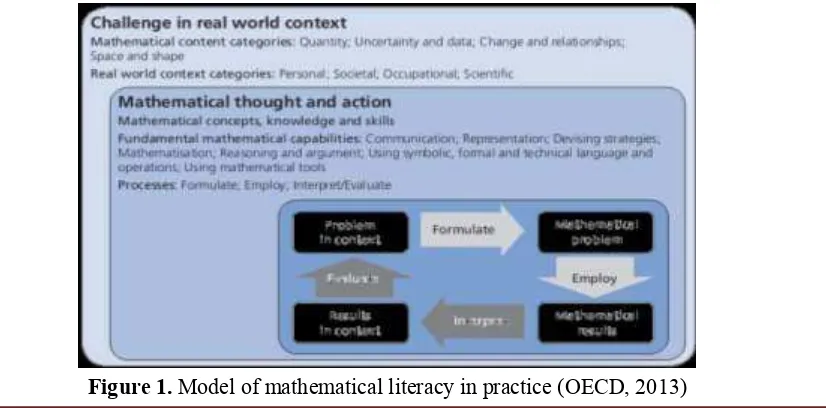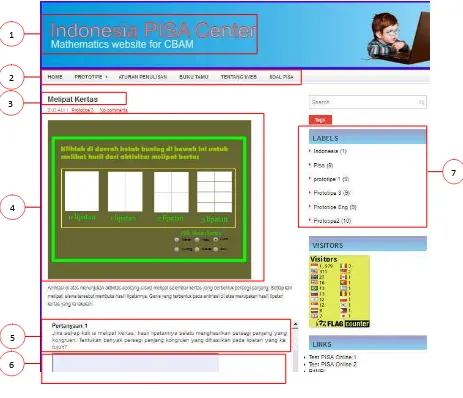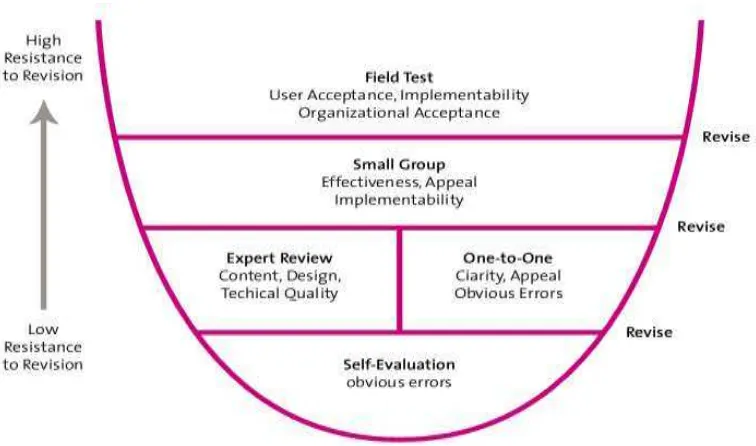This paper has been presented at Sriwijaya University Learning and Education-International Conference 2014. Faculty of Teacher Training and Education, Sriwijaya University, Palembang, May 16—18, 2014.
D5-702 problems (OMP). The aim of this research is to know what are student responses when they answered OMP like PISA. The data collected by using online test and interviews which are administered to twenty student grade 10th at Kusuma Bangsa, Palembang, Indonesia. The method are used in this research is development research which consist of three stage namely; preliminary, prototyping, and assessment. But for this paper focuses only on the result of field test and interviews to 5 students after they solved online mathematical problems. In field test, 20 problems are tested to the student. By using online mathematical problem assessment, the student got new experience (how to answer online question), various of ways to find solution. On interview, the student agrees that online assessment is effective and fit on modern society and they can use continuously.
Key Words: OMP, PISA, Student responses
INTRODUCTION
Nowadays, developing of Information and Communication Technologies (ICT) are so fast. Using of computer is a reflection of importance of ICT for working mathematically in modern societies. It is caused by using computer provides a range of opportunities for designers to write test items that are more interactive, authentic and engaging, and which may move mathematics assessment away from the current strong reliance on verbal stimuli and responses, enabling different student abilities to be tapped (Stacey, 2012; OECD, 2013). Moreover, by using computer allows making test more interactive (Zhang, 2010; Stacey, 2012). Peck and Domcott (Al-Zaidiyeen, Mei, & Fook, 2010) also claimed that there is a reason why computer which is supported by internet conection is important in education, because of computer can be used to test new knowledge.
For PISA (Programme for International Student Assessment), using ICT is a new optional to asses student skills and knowledge of 15-year old. It is called Computer-Based Assessment of Mathematics (CBAM). In 2012, at least 67 countries (including all 33 of the OECD member countries) will participate in the main survey, with many undertaking the optional components, including CBAM, general problem solving, financial literacy, parent and teacher questionnaires and a student questionnaire on familiarity with ICT. The first results from the 2012 survey should appear near the end of the year (Stacey, 2012).
This paper has been presented at Sriwijaya University Learning and Education-International Conference 2014. Faculty of Teacher Training and Education, Sriwijaya University, Palembang, May 16—18, 2014.
D5-703
To response the lowest Indonesia student achievement many strategies, decisions, and researches had been done by Indonesia government and stakeholder. The change of Indonesian curricula is one of the effects of the lowest achievement in PISA (Kemdikbud, 2012; Kemdikbud 2013). Many researches about PISA also have been done in Indonesia to prepare Indonesia student in the next PISA (Novita, Zulkardi, & Hartono, 2012; Kamaliyah, Zulkardi, & Darmawijoyo, 2013; Edo, Hartono, & Putri, 2013; Lutfianto, Zulkardi, & Hartono, 2013). But in preparing Indonesian student by change curricula, gave problems and then analyzed the problems that are made did not enough as PISA’s team has always re-developed and expanded framework for mathematical literacy. One of them is CBAM or online mathematical problems.
Theoretical Background PISA
PISA (Programme for International Student Assessment) is an international assessment of the skills and knowledge of 15-year old (Shiel et al, 2007; OECD, 2009). There are five kinds of skill and knowledge are assessed in PISA i.e. mathematics literacy, reading literacy, science literacy, problem solving literacy and financial literacy (OECD, 2003; OECD, 2009; Stacey, 2011, OECD, 2013) The first time, this international scale assessment had been conducted on 2000 by Organization for Economic Co-operation and Development (OECD)(Shiel et al, 2007; OECD, 2009; OECD, 2010; OECD, 2013). PISA is conducted every 3 years and many countries participated in PISA, include Indonesia.
The purposes of mathematics literacy are to improve an individual’s capacity to formulate, employ, and interpret mathematics in a variety of contexts. It includes reasoning mathematically and using mathematical concepts, procedures, facts and tools to describe, explain and predict phenomena. It assists individuals to recognize the role that mathematics plays in the world and to make the well-founded judgments and decisions needed by constructive, engaged and reflective citizens (OECD, 2013).
Mathematics literacy in PISA is usually designed by give contextual problems. Context related to personal contexts, societal context, occupational context, and scientific context. All contexts above can be drive to four contents in PISA such as quantity, uncertainty and data, change and relationships, and space and shape (OECD, 2012; OECD 2013). The following is model of mathematical literacy in practice.
This paper has been presented at Sriwijaya University Learning and Education-International Conference 2014. Faculty of Teacher Training and Education, Sriwijaya University, Palembang, May 16—18, 2014.
D5-704
CBAM or OMP
To produce OMP which are assessed by using computer, there are three applications which were used in this research namely Adobe flash, Blog/web-blog, and Google Form.
Adobe flash
By using adobe flash, the researcher could create more interactive and authentic picture. Because of flash can manipulate vector and raster graphics, and supports streaming of audio and video. It contains a scripting language called ActionScript (Adobe, 2013). ActionScript is easily the most widely used language in new media. Its functionality is applicable in industries such as web design, game design, courseware development, and enterprise-level application development. Developers or graphic designers possessing a keen sense of proper ActionScript usage open a whole new level of opportunity for their career (Milbourne, Kaplan, & Oliver, 2009).
Blog/web-blog
Blog/web-blog are is a website that is maintained by an individual or group with regular updates of information; this information could include diary entries, descriptions of events or in this case educational material. In most blogs readers can supply comments to blog entries, this allows them to ask questions, add information to the blog post or simply comment on a good/bad post (Curran et al, 2011). Blog/website as a useful tool of providing learning experiences to students in the process of enhancing students’ knowledge retention thus improve their academic performances (Jaaman et al, 2013).
Blogs differ from traditional websites and provide many advantages over traditional sites, including:
1. Easy creation of new pages, since new data is entered into a blog usually through a simple form and then submitted with the blogger (or person adding the entry to the blog website) updating the blog with little or no technical background — blogs have thus become the novice’s web authoring tool.
2. Filtering of content for various blog entries, for example by date, category, author, or one of many other attributes.
3. Most blog platforms allow the blog administrator to invite and add other authors, whose permissions and access are easily managed.
4. Providing a personal writing space that is easy to use, sharable, and automatically archived. 5. Ability to link and inter-link to form learning communities.
6. Opportunity to serve as a digital portfolio of students’ assignments and achievements. 7. Extensions into fully featured content management systems.
(Duffy & Bruns, 2006)
Google form
This paper has been presented at Sriwijaya University Learning and Education-International Conference 2014. Faculty of Teacher Training and Education, Sriwijaya University, Palembang, May 16—18, 2014.
D5-705
teacher, and with the course material. Moreover, more students complete their homework assignments on time, and test scores have also improved for many students.
PISA’s Problems on CBAM
CBAM was developed in this research adopting the first research about CBAM (Stacey, 2012). All information about first research about CBAM can be accessed at http://cbasq.acer.edu.au/index.php? cmd=toMaths. Meanwhile, within this research all problems and writing rules can be accessed at http://www.indonesiapisacenter.com/. In this website, the student can see all questions, use the animation to help understood the problem, and submitted the answer.
In Indonesia, Indonesia PISA Center is the first website provided problems like PISA where the students able to solve problems through online. In this website also published previous PISA problems which are tested internationally on 2006 and 2012. The figure below is appearance of CBAM which was developed by researcher.
Figure 2. CBAM appearance Explanation of Figure 2:
2 1
3
4
5
6
This paper has been presented at Sriwijaya University Learning and Education-International Conference 2014. Faculty of Teacher Training and Education, Sriwijaya University, Palembang, May 16—18, 2014.
D5-706
1. Title of website. It is consist of title and subtitle respectively Indonesia PISA Center and Mathematics Web for PISA
2. Menu dropdown appearance
3. Title of problem. For example folding paper
4. The animation of folding paper. The student can use it to know number paper that are produced when the folding a paper. The animation was created by using adobe flash CS 4 and action script 3 as language programming.
5. Question of problem 6. Space for input the answer
7. Additional menu for short cut menu or classified category of posts.
METHOD
Method was used in this research is development research that has focus on student responses about OMP. The research was conducted in three phases; preliminary stage, prototyping stage, and assessment stage (Nieveen & Plomp, 2007). In the preliminary stage, the researcher conducted analysis curricula, analysis subject, analysis supporting media, and made instrument for collecting data such as PISA questions, rubric, interviews guidance, and sheet of walk through. These processes produced first prototype (prototype I). On prototyping stage, 4 phases would be passed i.e. self-evaluation, expert review, one-to-one, small group, and field test. Figure 2 is flow chart of formative evaluation.
Figure 3. Flow chart of formative evaluation.
This paper has been presented at Sriwijaya University Learning and Education-International Conference 2014. Faculty of Teacher Training and Education, Sriwijaya University, Palembang, May 16—18, 2014.
D5-707
RESULT AND DISCUSSION
In this section, the researcher focuses on student responses when they used OMP. The responses collected by using online test and interviews after they did it.
Student’s responses about OMP in online test.
To collect student result on online mathematical problems, the researcher used online test to do it. The students are also able to use pencil and paper to assist their thinking processes (Stacey 2012). The following are one of the online mathematical problems which have tested to student.
Questions:
Every dash line which is produced by folding activity will be cut to be lottery papers. If Ketut has 3 same papers and he folds altogether. How minimum folds are needed to produce 42 lottery papers? Show your work!
Based on the problem above, they are asked to use animation for helping solve problems. They could use different color to make pattern with different appearance. A half of student (11 of 20 students) could answer correctly this problem. To answer this problem, they also used several of strategies to get result. The following is student work result:
This paper has been presented at Sriwijaya University Learning and Education-International Conference 2014. Faculty of Teacher Training and Education, Sriwijaya University, Palembang, May 16—18, 2014.
D5-708
Translate:
If they did one fold then produced 6 paper
2x (two folds) produced 12 pieces of paper
3x (three folds) produced 24 pieces of paper
4x (four folds) produced 48 pieces of paper
So minimum folds are 4
Second strategy:
Translate:
The minimum folds = 42/3 = 14
24 = 16,
So minimum folds are 4 for every piece of paper
If we look at the first strategy and the second strategy, they have differences. For the first strategy, Student counted number of fold respectively. He/she started by one folds and then calculate number of piece paper which were produced. So he/she got minimum of folds which are needed. In other hand, at the second strategy, He/she divided number of pieces paper needed by number of initial papers. Because he/she knew the pattern of one paper when it folded is 2n (n: number of fold). So they used n minimum to produce more than 14 pieces of paper. Beside that, the student also used other strategies to solve the problems above.
Student’s responses about OMP in Interviews
To know the students’ responses of this research, the researcher conducted interview in field test step. In field test, there are four students who were interviewed by giving same question. The following are questions asked to the students and students’ responses on interview in field test.
1)
Can OMP be implemented?This paper has been presented at Sriwijaya University Learning and Education-International Conference 2014. Faculty of Teacher Training and Education, Sriwijaya University, Palembang, May 16—18, 2014.
D5-709
The students also answered “yes, It can” and one of their reasons are OMP can be accessed anytime and anywhere.
3)
Is OMP fit on modern society?All students agree that online assessment is effective and fit on modern society. It is caused by nowadays all technologies using computer.
CONCLUSION
Based on the result and discussion of this research, it can be concluded that to know the student responses about CBAM, the researcher conducted interview and administered online test in field test step. Based on the student’s argumentation such as the website easy to use, the problems can be understood by students, the student agrees that online assessment is effective and fit on modern society and they can use continuously. By using online mathematical problem assessment, the student got new experience (how to answer online question), various of ways to find solution.
REFERENCES
Adobe. (2013). History of Adobe Flash, (Online), http://s3.amazonaws.com/ppt-download/adobeflashpresentation-100215231945-phpapp01.ppt
Al-Zaidiyeen, N. J., Mei, L. L., & Fook, F. S. (2010). Teachers’ Attitudes and Levels of Technology Use in Classrooms: The Case of Jordan Schools. International Education Studie , 3(2): 211--218.
Duffy, P. & Bruns, A. (2006). The Use of Blogs, Wikis and RSS in Education: A Conversation of Possibilities. Proceedings Online Learning and Teaching Conference 2006, 31-38.
Edo, S. I., Hartono, Y., & Putri, R. I. (2013). Investigating Secondary School Students’ Difficulties in Modeling Problems PISA-Model Level 5 And 6 . IndoMS. J.M.E , 41-58.
Google, (2013). Create Google forms, (Online), https://support.google.com/ drive/answer/87809?hl=en.
Kamaliyah, Zulkardi, & Darmawijoyo. (2013). Developing the Sixth Level of PISA-Like Mathematics Problems for Secondary School Students . IndoMS. J.M.E , 9-28.
Kemdikbud (2012). Bahan Uji Publik Kurikulum 2012, (Online), http://118.98.166.62/application/media/file/Laman%202012/Bahan%20Uji%20Publik%20Kur ikulum%202013.pdf .
Kemdikbud. (2013). Salinan Lampiran Peraturan Menteri Pendidikan dan Kebudayaan Nomor 69 Tahun 2013 Tentang Kerangka Dasar dan Struktur Kurikulum Sekolah Menengah Atas/Madrasah Aliyah. Jakarta.
Lutfianto, M., Zulkardi, & Hartono, Y. (2013). Unfinished Student Answer in PISA Mathematics Contextual Problem. IndoMS-JME , 188-193.
Milbourne, P., Kaplan, C., & Oliver, M. (2009). The Essential Guide to Flash CS4 with ActionScript. United State of America: Friendsof.
Nieveen, N. & Plomp, T. (2007). Formative Evaluation in Educational Design Research (Eds): An Introduction to Educational Design Research. Enschede: SLO.
Novita, R., Zulkardi, & Hartono, Y. (2012). Exploring Primary Student’s Problem-Solving Ability by Doing Tasks Like PISA’s Question . IndoMS. J.M.E , 133-150.
OECD. (2003). Literacy Skill for the World of Tomorrow: further results from PISA 2000, (Online), f http://www.oecd.org/edu/preschoolandschool/2960581.pdf.
OECD. (2009). Learning Mathematics for Life: A Perspective from PISA. Paris: OECD Publising. OECD. (2009). Take the Test: Sample Questions from OECD’s PISA Assessments. Paris: OECD
This paper has been presented at Sriwijaya University Learning and Education-International Conference 2014. Faculty of Teacher Training and Education, Sriwijaya University, Palembang, May 16—18, 2014.
D5-710
OECD. (2010). PISA 2012 Mathematics Framework, (Online), http://www.oecd.org/dataoecd/8/38/46961598.pdf.
OECD. (2013). PISA 2012 Assessment and Analytical Framework: Mathematics, Reading, Science, Problem Solving and Financial Literacy. Paris: OECD Publishing.
OECD. (2013). Indonesia Student Peformance (PISA 2012), (Online),: http://gpseducation.oecd.org/CountryProfile?primaryCountry=IDN&treshold=10&topic=PI, retrieved March 2nd, 2013.
Shiel, et al. (2007). PISA Mathematics: a teacher's guide. (Online), http://www.sdpi.ie/inspectorate/insp_pisa_maths_teach_guide.pdf.
Stacey, K. (2010). Mathematical and Scientific Literacy Around The World. Journal of Science and Mathematics, 33(1): 1--16.
Stacey, K. (2011). The PISA View of Mathematical Literacy in Indonesia. Journal on Mathematics Education (IndoMS-JME), 2: 95--126
Stacey, K. (2012). The International Assessment of Mathematical Literacy: PISA 2012 Framework and Items (Eds). Proceedings of The 12th International Congress on Mathematical Education, 756--772.


